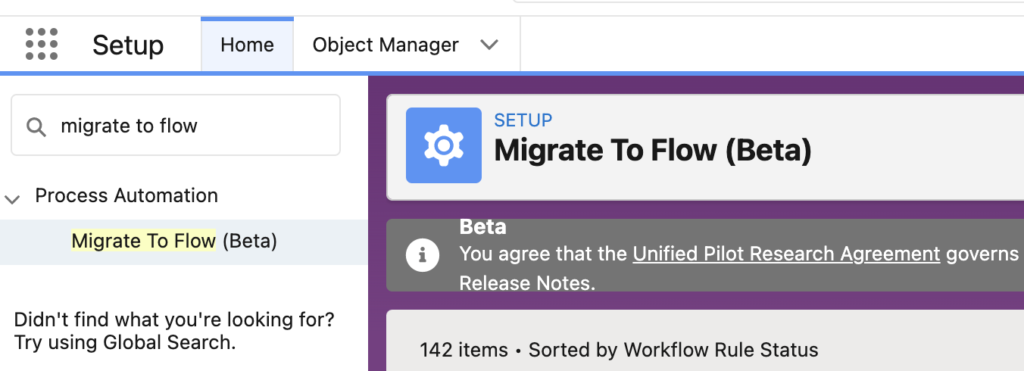
Salesforce Flow is getting better in every release. After all the great flow features that were announced in the Spring '22 release, there is almost no reason to create new workflow rules and Process Builder. Moreover, Salesforce announced that workflow rules and Process Builder will be deprecated in the near future. Therefore, it is time to start converting your existing workflow rules and Process Builder to flows. For this purpose, Salesforce released a new tool called Migrate to Flow Tool (Beta). Even though it converts only the existing workflow rules to flows, in the next release there will be a different tool for converting the existing Process Builders. Read this post to learn the retirement roadmap of workflow rules and Process Builder.
How to Use the Migrate to Flow Tool
In order to use the Migrate to Flow Tool, navigate to the setup and find it under the Process Automation.

This tool displays all of your workflow rules (both active and inactive rules). In order to convert a workflow rule, mark the radio button next to the workflow rule name and then click the Migrate to Flow button.

After you click the Migrate to Flow button, you will see this message for a few seconds and then the system will create a new record-triggered flow.

If your workflow rule is only updating fields, Migrate to Flow Tool creates a before-save flow, which is almost 10 times faster than an after-save flow. However, if your workflow rule has a send email action, an outbound message action, or a time-dependent action, then it creates an after-save flow since these actions are not supported in before-save flow.

At this stage, workflow rule is still active and the new record-triggered flow is inactive. Before switching workflow rule and flow activations, open the new flow in Flow Builder and test it. In order to open it, click the Test in Flow Builder button. After making sure that the flow is working fine, click on Switch Activations to deactivate the workflow rule and activate the new flow.
Considerations
Even though it is a fast solution to convert the existing workflow rules to flows, there are a few points to consider before using this tool.
- It creates a new record-triggered flow for each workflow rule. However, flow is an advanced automation tool that supports many actions and steps. Therefore, it is not the best practice to create a new flow for each workflow rule. Merge the new flows into a bigger flow instead of having many short flows.
- Workflow rules can run when a formula evaluates to true. However, some formula functions and merge fields are not supported as the start criteria of flows. Therefore, if your existing workflow rule runs when a formula evaluates to true and contains an unsupported formula, Migrate to Flow Tool cannot convert it to a flow.

- Migrate to Flow Tool doesn’t support the create task action. Therefore, if your workflow rule is creating a task, this tool cannot convert it to a flow.

- If you convert a workflow rule to a flow and then click the Migrate to Flow button again, it creates a new flow instead of creating a new version of the existing flow. In this case, don't forget to delete the older flows. Otherwise, you might have a mess.
Conclusion
Migrate to Flow Tool is a great tool to convert the existing workflow rules to flows. However, there are a few points to consider before using this tool. Some of these points are so critical that you might decide not to use it at all.
Salesforce announced that it is still in Beta. Therefore, we can expect some of these critical points to be solved in the next releases.
Read this article to learn more about the Migrate to Flow Tool.
Leave a Reply